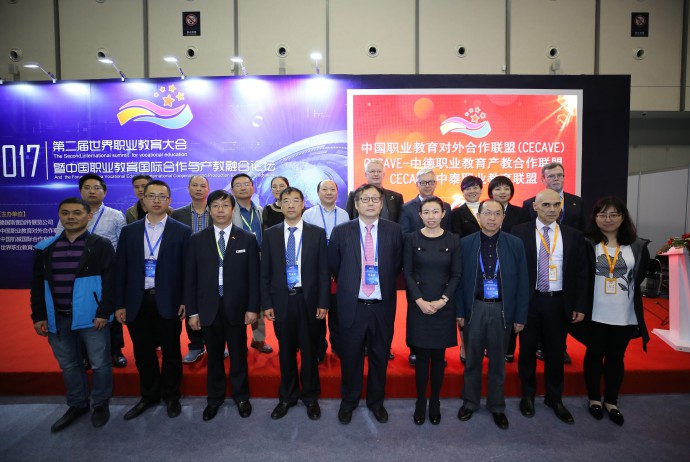On 21 October 2017, organisations and enterprises of vocational education formally established a “Sino-German Alliance on Dual Vocational Education” in Nanjing, capital of Jiangsu province. Different from already existing bilateral VET associations, the new alliance will, according to its Chinese name, focus on the cooperation between enterprises and schools, and thus focus on truly “dual” vocational education.
The alliance was founded at the “International Summit for Vocational Education”, which was part of Education Plus 2017, an exhibition organized by Messe Stuttgart Nanjing Ltd. During the constituting session, founding members adopted by-laws and unanimously elected their chairman, Simon Zhao. He is CEO of the National Center for Open & Distance Education in Beijing.
Simon Zhao pointed out the significance of founding this alliance at this time, as China formulates new goals for its economic development. “At present, speeding up the development of modern vocational education is a major strategic plan that the country has made. The plan demands to shift gears in economic growth, and requires structural adjustments and the transformation of old into new kinetic energy. It is also an inevitable requirement of China to achieve the goal of becoming an innovation-oriented country and to strengthen its human resources.”
Linking the German “Industry 4.0” approach to the “Made in China 2025” objectives, he further explained the connotation of internationalization in vocational education and said, “We should strive to explore the road of international cooperation in running schools, focus on the needs of regional economic and social development, regard international standards, employ international teachers, apply international management, and so develop a highly competitive, highly skilled workforce.”
Mark Ma, Vice General Manager of Open Education, referred to a 2016 study which estimated the vocational education market volume of China at 600 billion RMB (about 78 billion Euro) and further growing. “In this market, the new alliance aims at developing the cooperation of enterprises and schools in vocational education, supporting the implementation of the Sino-German vocational education strategy, and establishing a new and sustainable type of cooperation.”
The new alliance is a branch organisation of the “China External Cooperative Alliance of Vocational Education” in Beijing.
Objectives
The alliance aims to
- Establish a benchmark of vocational education in China by localizing German curricula into the Chinese system.
- Explore methods of developing vocational talents that are highly demanded by industry.
- Research German philosophy of skills transfer in vocational education.
- Apply the German quality assurance mechanism in China.
- Set up a Qualification Assessment Center based on German qualification standards.
- Train teachers by working closely with member enterprises and schools.
- Develop a significant number of senior managers to apply German learning techniques in Chinese colleges.
- Reduce the gap between vocational college graduates and industry needs.
- Provide German employers in China with qualified workers.
For more details on the assocation, contact liw@mail.open.com.cn.
For more details on the exhibition Education Plus, see our related article.
Image source: National Center for Open and Distance Education (OPEN)
Jiangsu ranks second in GDP among Chinese provinces and takes position 2×2 on the G8x8 chess board. In 2015, the province produced 7,011.6 billion RMB worth of goods and services, contributing 9.7 percent to the total GDP of China. Depending on the exchange rate, this was almost as much as the GDP of Australia.

